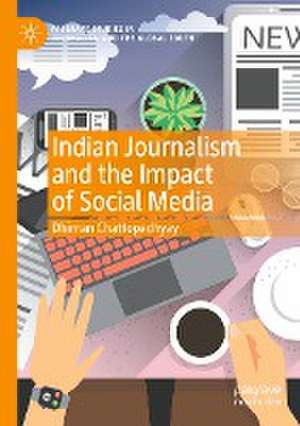Indian Journalism and the Impact of Social Media: Palgrave Studies in Journalism and the Global South
Autor Dhiman Chattopadhyayen Limba Engleză Paperback – 22 sep 2023
| Toate formatele și edițiile | Preț | Express |
|---|---|---|
| Paperback (1) | 637.59 lei 6-8 săpt. | |
| Springer International Publishing – 22 sep 2023 | 637.59 lei 6-8 săpt. | |
| Hardback (1) | 643.00 lei 6-8 săpt. | |
| Springer International Publishing – 22 sep 2022 | 643.00 lei 6-8 săpt. |
Preț: 637.59 lei
Preț vechi: 750.11 lei
-15% Nou
Puncte Express: 956
Preț estimativ în valută:
121.100€ • 127.84$ • 100.86£
121.100€ • 127.84$ • 100.86£
Carte tipărită la comandă
Livrare economică 12-26 aprilie
Preluare comenzi: 021 569.72.76
Specificații
ISBN-13: 9783031073205
ISBN-10: 3031073207
Pagini: 257
Ilustrații: XXV, 257 p. 4 illus.
Dimensiuni: 148 x 210 mm
Greutate: 0.34 kg
Ediția:1st ed. 2022
Editura: Springer International Publishing
Colecția Palgrave Macmillan
Seria Palgrave Studies in Journalism and the Global South
Locul publicării:Cham, Switzerland
ISBN-10: 3031073207
Pagini: 257
Ilustrații: XXV, 257 p. 4 illus.
Dimensiuni: 148 x 210 mm
Greutate: 0.34 kg
Ediția:1st ed. 2022
Editura: Springer International Publishing
Colecția Palgrave Macmillan
Seria Palgrave Studies in Journalism and the Global South
Locul publicării:Cham, Switzerland
Cuprins
1.Introduction.- 2.Journalism in an online-first era.- 3.Gates & influences: Theoretical framework.- 4.Building blocks: framework and methodology.- 5.Perceptions & influences: findings from the survey.- 6.Social media’s impact on Indian journalism: Editors speak.- 7.Emerging challenges & the way ahead.- 8.Implications.
Notă biografică
Dhiman Chattopadhyay is an assistant professor in the Department of Communication, Journalism and Media, at Shippensburg University, USA.
Textul de pe ultima copertă
“This outstanding book offers an important, in-depth look at how social media affect journalism in the world’s largest democracy. It’s a must-read for anybody interested in how journalists around the world cope with the challenges of digital news and information.”
Lars Willnat, John Ben Snow Research Professor, Syracuse University, USA
“…a must read for all media professionals and will provide valuable insights about the challenges and trends in current journalism practice in India.”
Sundeep Muppidi, Professor of Communication at the University of Hartford, USA
“…a comprehensive, thoughtful, and very readable analysis of the space social media occupies in Indian journalism.”
Jyotika Ramaprasad, Professor in the School of Communication at the University of Miami, USA
This book is a pan-India study that examines social media’s impact on Indian journalism, highlights emerging challenges, and discusses the way forward for India’s newsrooms. A result of three years of field work, the project uses mixed-methods research – a survey of nearly 300 journalists from 15 Indian cities, followed by in-depth interviews with 25 senior editors – to analyze and explain journalists’ perceptions about social media’s usefulness and credibility, factors that influence their online news sourcing and sharing decisions, resultant challenges for newsrooms, and ways to address those challenges. The findings offer unique insights into how newer forces are influencing journalistic practices in an online-first era. Key differences emerge in perceptions between Indian journalists and their Western compatriots about who or what influence their actions. The findings also raise questions about Gatekeeping as a term to describe journalistic work in 21st Century India's newsrooms. The findings and the conclusions will hopefully help journalists, educators, and anyone interested in Indian journalism gain a deeper, more meaningful understanding about social media’s impact on Indian journalism, and the way ahead for India’s newsrooms.
Dhiman Chattopadhyay is an assistant professor in the Department of Communication, Journalism and Media, at Shippensburg University, USA.
Caracteristici
Examines the impact of social media on Indian journalism Provides a survey of nearly 300 journalists from 15 Indian cities Offers unique insights into how new forces are influencing journalistic gatekeeping routines










